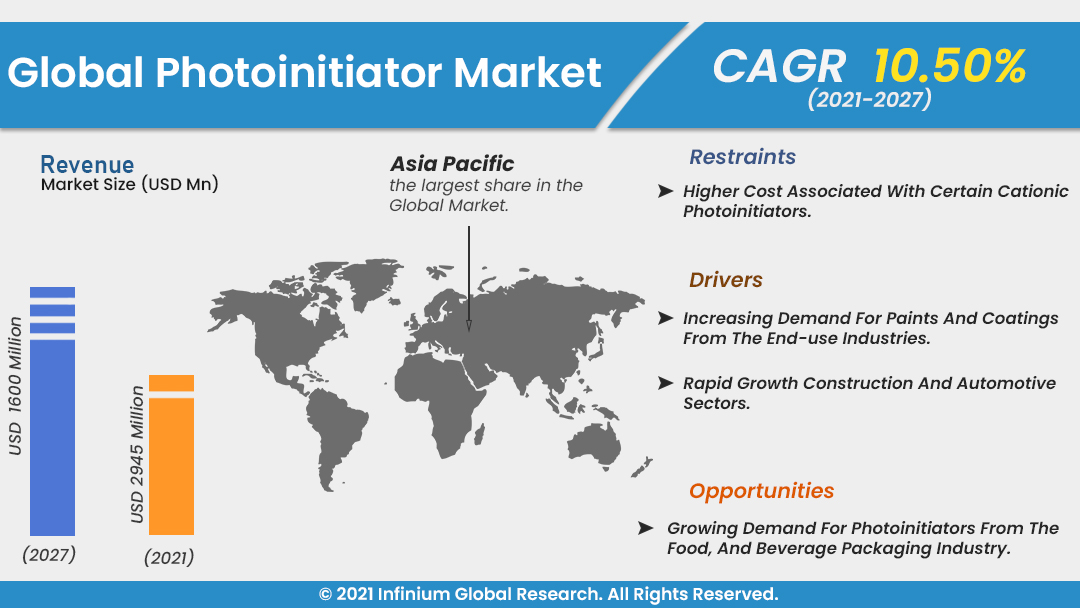Photoinitiator Market (Type - Free Radical, and Cationic; Application - Paints and Coating, Inks, Adhesives, Electronic Devices, and Others): Global Industry Analysis, Trends, Size, Share and Forecasts to 2027
A recent report published by
Infinium Global Research on the photoinitiator market provides in-depth analysis of
segments and sub-segments in the global as well as regional photoinitiator
market. The study also highlights the impact of drivers, restraints, and macro
indicators on the global and regional photoinitiator market over the short term
as well as long term. The report is a comprehensive presentation of trends,
forecast and dollar values of the global photoinitiator market. According to the
report, the global photoinitiator market is projected to
grow at a CAGR of 10.5% over the forecast period of 2021-2027, growing from
nearly USD 1,600 million in 2021 to about USD 2,945.1 million in 2027.

Market Insight
The polymer industry has gone
under several transformations over the past few years with the development of
innovative manufacturing processes, and chemicals. Photoinitiators are one of
the innovative materials used in polymer formulations to improve their physical
characteristics. A photoinitiator is a molecule that upon light absorption
induces photopolymerization, resulting in a highly cross-linked photopolymer.
The photoinitiators are classified into two basic types including free radical,
and cationic. Products such as paints, coatings, inks, and adhesives widely use
photoinitiators in the formulation. Photoinitiators offer faster curing,
long-lasting activity, and a smooth finish to the products. Moreover, products
with photoinitiators display superior properties including higher yield, better
abrasion, and stain resistance. Such advantages of photoinitiators augment
their use for various applications.
The spread of COVID-19 has
severely affected the photoinitiator market across the globe. The COVID-19 pandemic
affected the global photoinitiator market by impeding production and demand,
disrupting the supply chain, and by hampering the financial markets. The demand
for photoinitiators decreased from the end-users, as the pandemic severely
affected the revenue of end-user industries. Several end-users either reduced
their production or closed their production unit. Moreover, the shortage of raw
materials was another major challenge faced by the market during the pandemic.
Furthermore, the lower production of photoinitiators in countries such as
China, Taiwan, and Japan created a short supply in the global market. Other
countries dependent on the import witnessed a severe shortage of
photoinitiators during the pandemic. The lower production and shortage of
photoinitiators in the market were estimated to hamper the market growth in the
short term. However, as the pandemic crisis waned, the production and supply of
photoinitiators ramped up to their pre-pandemic state.
The increasing demand for paints
and coatings from various end-use industries is majorly driving the market
growth. The paints and coatings having photoinitiators offer several advantages
over traditional paints and coatings including ease of applying, quick-curing,
and ease to clean-up and re-coat. These advantages of photoinitiators are
anticipated to boost its adoption in paints and coatings. Moreover, the growing
construction and automotive sectors are supporting the growth of the
photoinitiator market. Construction and automotive industries widely use
products having photoinitiators for various applications including paints,
coatings, adhesives, and others. Thus, the growing construction and automotive
industries augment the growth of the photoinitiators market as they are the
leading end-use industries. However, higher cost associated with certain
cationic photoinitiators is majorly hampering the market growth. Costly
procurement of equipment and research and development together increase the price
of photoinitiators. Nevertheless, the growing demand for photoinitiators from
the food, and beverage packaging industry is anticipated to boost market growth
in the future. The many vendors are developing zero-toxicity photoinitiator to
use in the packaging of food, beverage, and personal care products.
In terms of region, the global
photoinitiator market is dominated by the Asia Pacific region. The presence of
a large consumer pool along with improving economic conditions is driving market growth in the Asia Pacific. Moreover, the growth of automobiles and
real-estate in the region augments the demand for photoinitiators in the Asia
Pacific. Furthermore, the growing urban population in the Asia Pacific is
further supporting the market growth for photoinitiators in the region. On the
other hand, the North American region accounted for the second-largest share in
the global photoinitiator market. The growing construction industry in North
America is anticipated to boost the demand for photoinitiators for paint,
coating, adhesive, and other applications. Additionally, the increasing
production and export of electronic goods in North America are further
augmenting the growth of the market.
Segment Covered
The report on the global
photoinitiator market covers segments such as type, and application. On the
basis of type, the sub-markets include free radical, and cationic. On the basis
of application, the sub-markets include paints and coating, inks, adhesives,
electronic devices, and others.
Companies Profiled:
The report provides profiles of
the companies in the market such as IGM Resins BV, Polynaisse Resources
Chemicals Co., Ltd., Arkema SA, Changzhou Tronly New Electronic
Material Co., Ltd., Double Bond Chemical Ind., Co., Ltd., Evonik Industries AG,
Rahn AG, DIC Corporation, TCI Europe NV, and Environ Speciality Chemicals Ltd.
Report Highlights:
The report provides deep insights
into demand forecasts, market trends, and micro and macro indicators. In
addition, this report provides insights into the factors that are driving and
restraining the growth in this market. Moreover, The IGR-Growth Matrix analysis
given in the report brings an insight into the investment areas that existing
or new market players can consider. The report provides insights into the
market using analytical tools such as Porter's five forces analysis and DRO
analysis of the photoinitiator market. Moreover, the study highlights current
market trends and provides forecast from 2021-2027. We also have highlighted
future trends in the market that will affect the demand during the forecast
period. Moreover, the competitive analysis given in each regional market brings insight into the market share of the leading players.
